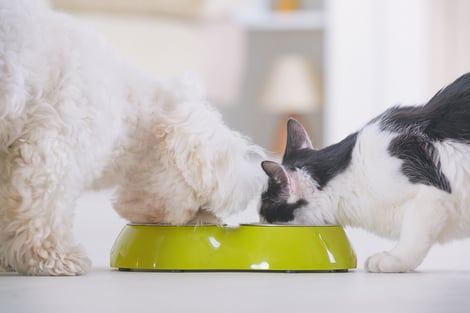
Good nutrition is important for pets to live long, healthy lives. But most pets rely on us to make food choices for them.
What is the best food for your pet? How do you sort through all the marketing claims to find affordable, healthy food for your dog or cat?
Here are some good sources for understanding what’s out there and how to feed your pet a healthy diet without breaking the budget.
Pet Food Options
Pet food can be expensive, and costs are increasing. An article from Tufts University School of Veterinary Medicine cites a wide variation in prices, depending on what kind of food you choose to feed your pet. The yearly cost of feeding a 55-pound dog could be as low as $201 and as high as $7,000. That’s a big difference.
In general, wet food is more expensive than dry, and “premium” fancy foods are more costly than supermarket brands.
The most expensive foods are freeze-dried, raw, or fresh. Not only are these foods super expensive, but there is also conflicting evidence about whether they are actually good for your pet. And these foods may contain dangerous foodborne pathogens.
If you’re on a tight budget, I’d suggest you choose a complete and balanced diet that meets your budget AND is a diet that your veterinarian believes will be healthy for your pet.
Your vet can steer you to a food that is right for your pet’s needs by looking at their age, life stage, lifestyle, body weight (or body condition score), health status, and activity level.
Commercial pet food companies that work with veterinary nutritionists make high-quality pet food. Sometimes these companies sell more affordable pet food brands because they manufacture their own pet food.
What about Raw Food?
The American Veterinary Medical Association (AVMA) recommends against feeding raw or undercooked protein sources to pets because of the danger of foodborne illness. That applies to creatures they have hunted or scavenged. The AVMA also says that an “organic” label doesn’t necessarily mean a food is safer or more nutritious.
This is why most veterinarians are reluctant to recommend a raw food diet to their clients.
But… if you believe that a fresh or raw food diet is best for your pet, regardless of the above warnings about the higher cost, that it’s less convenient than traditional pet foods, and because you’re highly motivated, then there is some good news for you and your veterinarian.
In 2020, Lindsay Meyers, CVT, BS at Primal Pet Foods, presented information to veterinarians about the risks and rewards of feeding fresh and raw foods. These are the scientifically based resources that she recommended, which you can share with your veterinarian.
- American College of Veterinary Nutrition (ACVN) resources
- World Small Animal Veterinary Association (WSAVA) resources
- Balance It
- Raw Fed and Nerdy
- Primal Pet Foods
Meyers made it clear that feeding fresh or raw is NOT recommended for feeding puppies or kittens. If it isn’t a complete and balanced diet during their younger years, despite your best efforts, it could lead to lifelong harm to the health of your growing pet.
Cooking Your Own Pet Food
Not everyone has the time or inclination to cook for their pets, but some people swear by it. If you are interested in learning about cooking for your dog or cat, you should do some research first to make sure you are feeding them a complete and balanced diet. The American Kennel Club has some recommendations here, including warnings about inadequate or dangerous recipes that show up on the internet.
The website Balance It is run by a board‑certified veterinary nutritionist. The site helps you customize and create pet recipes that include
- A protein‑rich food like beef, lamb, chicken, or fish
- A dense carbohydrate like barley, beans, bread, garbanzos, or oats
- Oils and fats that are okay for animals like peanut, canola, almond, or soybean
- Vegetables like carrots, cauliflower, green beans, and peas
- Fruits such as apples, bananas, blueberries, and cantaloupe
When cooking for your pet, it’s always critical to keep in mind that some foods and other household items are toxic to cats and dogs. Dogs should not eat anything that contains the artificial sweetener Xylitol, grapes, chocolate, onions, fatty and fried foods, macadamia nuts, or avocados.
Help Your Pet Maintain a Healthy Weight
Just like humans, pets need to exercise to burn calories. One of the most common health problems for dogs and cats is obesity. The Association for Pet Obesity Prevention reported that more than 55% of dogs in the United States are overweight or obese.
Not every obese animal is eating too much. Genetic conditions, hormonal imbalances, and lifestyle factors can affect their weight. If your pet is gaining weight, talk to your vet about nutrition and lifestyle changes.
Of course, exercise is important and healthy for pets and people. Learn some tips for exercising your dog here.
Read the Fine Print
Pet food companies want you to buy their food. And pet food is big business. That’s why even celebrity chefs are getting in on the action and marketing pet food.
But not all foods are created equal. If you want to know what is in your pet’s food, the Association of Animal Feed Control Officials (AAFCO) has a great resource to help you understand what the ingredient list means.
Look for the AAFCO statement that says the product is “formulated to meet AAFCO standards” for the life stage of your pet: puppy/kitten, adult, pregnant, lactating (nursing puppies or kittens), or senior dog/cat.
Find out if the company does actual animal feeding tests for the right life stage. Some foods say that they are used for “intermittent and supplemental” feeding. That’s not what you want to feed your pet every day. And it probably costs more than you want to pay.
Talk to Your Vet
One of the best things you can do to make sure your pet is eating a nutritious diet is to talk with your veterinarian and clinic staff.
Be prepared to answer questions about everything your pet eats, which includes treats and food prepared for people (table scraps, takeout leftovers, etc.), as well as how much, and how often. And ask any others who interact with your pet if they feed your pet any additional food or treats that can give your vet a complete understanding of your pet’s diet.
Bring the nutrition labels—or take pictures of them—from commercially available food and treats so you can tell your vet exactly what your pet eats on a regular basis. And tell your veterinarian why you made those choices in feeding your pet.
It’s not easy to untangle the claims of pet food companies, but we can do it together—so you and your pet can live a long, healthy life together.

